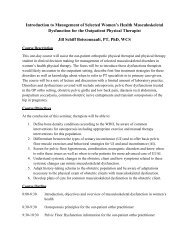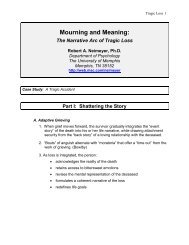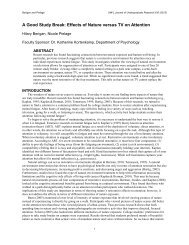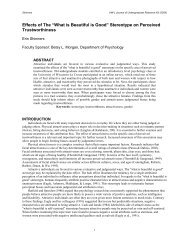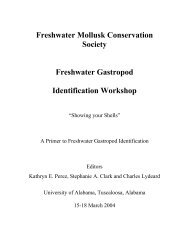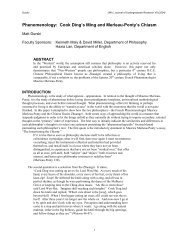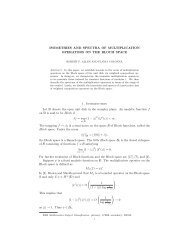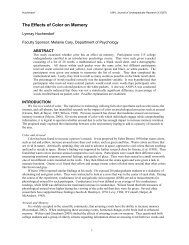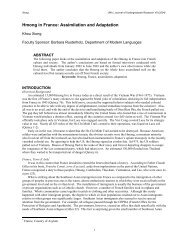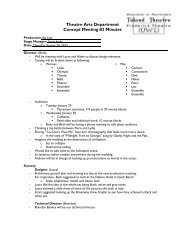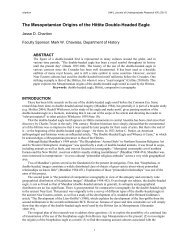Sister Sister: Interpreting Intimacy in Sibling Relationships
Sister Sister: Interpreting Intimacy in Sibling Relationships
Sister Sister: Interpreting Intimacy in Sibling Relationships
You also want an ePaper? Increase the reach of your titles
YUMPU automatically turns print PDFs into web optimized ePapers that Google loves.
Stach UW-L Journal of Undergraduate Research X (2007)<br />
with differ<strong>in</strong>g levels of <strong>in</strong>timacy. Another limitation is due to the fact that the topic itself was so personal <strong>in</strong> nature.<br />
The participants might not have felt completely comfortable shar<strong>in</strong>g <strong>in</strong>timate moments between herself and her<br />
sister with the researcher. This research was also biased <strong>in</strong> the sense that all participants were white and from<br />
Wiscons<strong>in</strong>. It’s possible that differ<strong>in</strong>g results would occur if this was opened up to other areas and cultures. F<strong>in</strong>ally,<br />
the researcher is not seasoned <strong>in</strong> this type of project.<br />
Future Research<br />
While this study answered the presented research questions, there are more questions to be answered on the<br />
topic of <strong>in</strong>timacy <strong>in</strong> sister relationships. Further research<strong>in</strong>g this topic will only more greatly enhance our<br />
understand<strong>in</strong>g of the phenomenon and its effects on a person’s life.<br />
One idea for a future study is to <strong>in</strong>terview pairs of sisters together. This would allow for the sisters to help each<br />
other, and the researcher, to better understand what comprises <strong>in</strong>timacy <strong>in</strong> their relationship. The researcher could<br />
also observe their nonverbal <strong>in</strong>teractions and use this as another way to conceptualize the study. The way the sisters<br />
talk together and metacommunicate throughout their <strong>in</strong>terview could also provide further <strong>in</strong>sight <strong>in</strong>to the<br />
components of <strong>in</strong>timacy <strong>in</strong> sister relationships.<br />
Another th<strong>in</strong>g that could be done <strong>in</strong> future research would be to use a comparison group. This group could be<br />
<strong>in</strong>timate friends of the participants, or brothers with whom they are close to, or possibly even pairs of brothers.<br />
See<strong>in</strong>g how sister relationships differ from other <strong>in</strong>timate relationships could show additional ways <strong>in</strong> which the<br />
relationship is unique and stands out from others.<br />
A third way <strong>in</strong> which this study could be altered to enhance the study would be to use both qualitative and<br />
quantitative methods. By us<strong>in</strong>g and analyz<strong>in</strong>g a simple survey about the topic, more <strong>in</strong> depth and relative <strong>in</strong>terview<br />
questions could be found. This would maximize the amount of <strong>in</strong>formation that could be ga<strong>in</strong>ed from the <strong>in</strong>terviews,<br />
as well as provide more orig<strong>in</strong>al research to the study.<br />
CONCLUSION<br />
In sum, this research illum<strong>in</strong>ates an understand<strong>in</strong>g of an understudied relationship with<strong>in</strong> the family—sisters.<br />
The sibl<strong>in</strong>g relationship <strong>in</strong> general is one of the most significant because most of one’s life is spent with one’s<br />
sibl<strong>in</strong>g(s). This study takes this idea a step further and f<strong>in</strong>ds that the relationship between two sisters <strong>in</strong> particular<br />
can be especially important. The qualitative methods used, <strong>in</strong>clud<strong>in</strong>g the semi-structured <strong>in</strong>terviews of females <strong>in</strong> a<br />
self-def<strong>in</strong>ed close relationship with their sister, proved to be sufficient <strong>in</strong> answer<strong>in</strong>g the proposed research questions.<br />
Results of these <strong>in</strong>terviews were found and analyzed and a few important themes emerged. Each of the participants<br />
<strong>in</strong> this study have been affected very positively by their sisters and are able to f<strong>in</strong>d ways to communicate this to one<br />
another. <strong>Sister</strong>s most def<strong>in</strong>itely have the ability to have a unique and significant relationship, and each of the<br />
participants <strong>in</strong> this study found themselves lucky enough, and proud to be a part of one.<br />
REFERENCES<br />
Arliss, L. A. (1993). Contemporary family communication. New York: St. Mart<strong>in</strong>’s Press.<br />
Baxter, L. A., & Babbie, E. R. (2004). The basics of communication research. Belmond, CA: Wadsworth.<br />
Bedford, V. H. (1993). <strong>Relationships</strong> between adult sibl<strong>in</strong>gs. In A. E. Auhagen & M. von Salisch (Eds.),<br />
Interpersonal relationships (pp. 119-141). Gott<strong>in</strong>gen: Hogrefe, Verlag fur Psychologie.<br />
Brody, G. H. (1998). Sibl<strong>in</strong>g relationship quality: Its causes and consequences. Annual Review of Psychology, 49, 1-<br />
24.<br />
Cicirelli, V. G. (1995). Sibl<strong>in</strong>g relationships across the life span. New York: Plenum.<br />
Connidis, I. A. (1989). Sibl<strong>in</strong>gs as friends <strong>in</strong> later life. American Behavioral Scientist, 33, 81-93.<br />
Cross, S. E., & Gore, J. S. (2004). The relational self-construal and closeness. In D. J. Mashek & A. Aron (Eds.)<br />
Handbook of closeness and <strong>in</strong>timacy. (pp. 229-245). Mahwah, New Jersey: Lawrence Erlbaum Associates.<br />
Far<strong>in</strong>elli, L., & Mikkelson, A. (2005). Attachment styles and relational development <strong>in</strong> adult sibl<strong>in</strong>g relationships.<br />
Paper presented at the International Communication Association annual meet<strong>in</strong>g, New York.<br />
Floyd, K. (1996). Communicat<strong>in</strong>g closeness among sibl<strong>in</strong>gs: An application of the gendered closeness perspective.<br />
Communication Research Reports, 13, 27-34.<br />
Floyd, K. & Parks, M. R. (1995). Manifest<strong>in</strong>g closeness <strong>in</strong> the <strong>in</strong>teractions of peers: A look at sibl<strong>in</strong>gs and friends.<br />
Communication Reports, 8, 69-76.<br />
Frey, L. R., Botan, C. H., Friedman, P. G., & Kreps, G. L. (1992). <strong>Interpret<strong>in</strong>g</strong> communication research, a case<br />
study approach. Upper Saddle River, NJ: Prentice Hall.<br />
14



